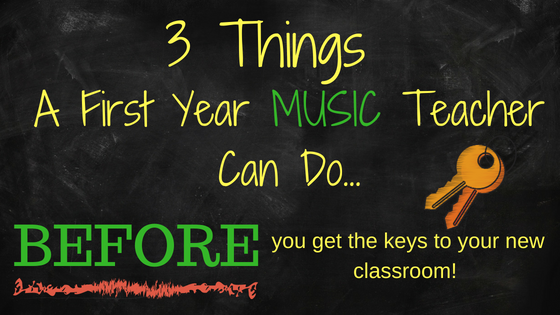If you are looking for a post about how to decorate your classroom or how to write a lesson plan or plan a performance, this is not that post.
As a first year music teacher you may be facing hours of professional development with other first year teachers, most of whom don’t teach music. Maybe you are organized, maybe you aren’t. Perhaps you have been collecting teaching materials since your freshman year of college. Maybe this new job as a music teacher is your emergency fall back plan because your music performance degree isn’t paying the bills. You may have visited your classroom, maybe not. You might have an idea of some of your resources, maybe not. You might be the only music teacher on your campus or you could be blessed with a coworker who can show you the ropes. You could be stepping into an urban Title 1 school where the students haven’t eaten today because the free summer meal program isn’t open on Sundays. You might have been hired to teach at a school where your students spent their summers at Disney World or in Paris. Regardless of the situation you have signed onto for the year, whether you are filled with excitement or dread or a combination of both there are three things that you can do before you even get your classroom keys that will make a HUGE difference in quality of your year. Here they are:
- Observe children
- Observe teachers
- Learn songs
That’s it! There are LOTS of really great things you can spend your time on right now, but with every free moment you have, spend it doing these three things. Below I will tell you why and how to do these 3 things.
OBSERVE CHILDREN –
It is impossible to plan musically meaningful lessons for tiny humans if you don’t know what tiny humans find musically meaningful. Seek out places where you can volunteer with or observe children. If finding a place to volunteer feels overwhelming, don’t worry because nowadays we have YouTube! YouTube is jam packed of classroom videos of children engaged in musical play. Now, in these videos, it is often true that the teachers involved save the video as a sort of performance, and all we see is the evidence of what the children have learned and not necessarily the path to get there. However, within these informal performance videos, you can catch a glimpse of what their teachers consider as mastered enough for video. These videos vary in quality, but if you watch enough, you will begin to notice that children exhibit varying degrees of confidence and delight in a given activity. You will also begin to see the differences in behavior between children who are giving themselves over the play of the activity and those who are going through the motions. If you can’t tell the difference, then you need more observation. As you watch the videos, see if you can spot the children who ALMOST have it. See if you can spot the children who have it, but who are bashful about showing what they know. Which of the children are ready for a bigger challenge? Ninety percent of the work you will do during a regular teaching job involves observing children and making judgements about how to move them forward. It takes practice, but is worth the effort.
These videos are of students being taught by my friend George Dozet, from California. In both of these videos, George has played the song experience games in the video with the classes for a while, and now the students are ready to share the game. The first video is of younger students while the second video is of older students. Take careful note of the difference in the game, the response of the children.
To learn more about how to facilitate a playful, prosocial experience for your students in during music class, check out Richards Institute of Education and Research website, which will be updated soon with course information for the 2018-2019 year. The organization offers courses around the country in the fall and spring and hosts a wonderful weeklong course in the summer. This group can also be found on FACEBOOK.
OBSERVE TEACHERS
Live teaching is best, but it’s summer and school is about to start, so once again, I advise going to YouTube and observing teachers in model lessons. Often model lessons will have other adults in the room and it could be argued that this changes the dynamic. HOWEVER, more often than not, the children just behave the way the would anyway. When you observe a teacher, take notes about what worked. Why was something successful? Was there a time in the lesson when the teacher clearly redirected the students or shifted gears? Why and how did this happen?
Here are some GREAT videos of children and teachers interacting. There are LOTS of these with different teachers serving as master teachers. These videos are a gift!
LEARN SONGS
Finding time to plan a good lesson is ALWAYS hard, no matter how long you teach. However, it is MUCH MUCH easier, when as the teacher you don’t have to learn every song that you teach before you teach it. Lessons take a lot of preparation, even when you know the music, so as you prepare for your first teaching job, take the time to learn some songs AND the games that might be played with them. ALSO, whatever piano, guitar, ukulele, recorder, violin, or kazoo skills you have developed in your life, practice enough so that you can play some of these songs you will learn by memory standing up or walking around while not looking at your hands and holding a conversation.
Here is a playlist (which is one of many) singing game videos. These videos were made in a music education class, so obviously these are not children playing, BUT this resource is a GREAT way to learn repertoire that may prove useful. As a music teacher who has spent FAR more time in a school without a budget than in a school with a budget, my favorite part about these songs is that the children don’t need anything to play them. If you teach on a cart, there are song experiences you can play. If you have a room, but it is empty and you don’t have any stuff yet, don’t worry, you can sing and play with the children and create a solid foundation of beautiful music from which music literacy can emerge without spending a cent.
Here is a link to the playlist
Here are a couple of my favorites that I sing and play with my students.
The songs I have selected from this playlist can be found in the book, “Let’s Do It Again!” by Mary Helen Richards. My only critique of the videos is that the college students (because they are college students) who don’t have a lot of space or interest in REALLY playing the games do not exhibit the same level of joy and delight that a child would express. I mention this because, in order for these videos to be of benefit to you, you must look beyond the young adults playing the games to the children who would truly love them. When YOU teach them, these games should be played as though each turn you have with the children is your favorite turn ever, no matter how many times you (the adult) have played. Also, I will caution you that a game that the college students seem to enjoy more like (Kitty Kitty Casket) is generally better suited for older children. A game that the college students seem to tolerate like (Come and Follow Me) is a game that would be better suited for younger children. The BEST place to gain an understanding of which sort of game will suit a particular age of child is to attend an Education Through Music course offered by the Richards Institute of Education and Research.
Your first year is going to be intense, but very rewarding. My prayer for you is that you will have a marvelous year and I wish you all the best!

